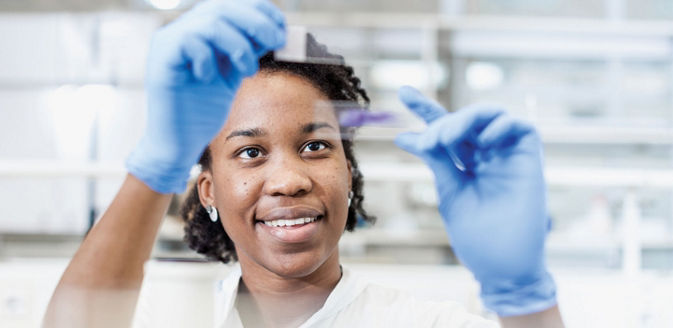For localized information and support, would you like to switch to your country-specific website for {0}?
HER2: Expressing potential beyond breast cancer
HER2, also known as Erb-B2 Receptor Tyrosine Kinase 2 (ERBB2), is driving new developments across a variety of cancer types
HER2 is well-established biomarker with a history of prognostic and predictive utility. Overexpression and amplification of this oncogene drives deregulation of several key signaling pathways. It is through this deregulation of cell signaling that HER2 can promote cell growth, proliferation and apoptosis. However, we now have evidence showing that HER2 may play an important part for understanding solid tumours.
- Amplification or overexpression of HER2 occurs in approximately 15-30% of breast cancers and 10-30% of gastroesophageal cancers. Overexpression of HER2 has also been noted in cancer of the ovaries, endometrium, bladder, lung, colon, head and neck.1
Reignited interest in the potential of HER2-related applications stems, of course, from the impact of its ground-breaking beginnings.

HER2 back then
In 1998, we saw the first-ever companion diagnostic test alongside the FDA approval of Herceptin® (trastuzmab). The test identifies excessive levels of HER2 in a tumour, indicating that Herceptin® could be an effective treatment for those patients.
This revolutionary pairing transformed breast cancer treatment and paved the way for future therapies to come to fruition.2,3
Key factors driving advancements in HER2

Biomarker understanding and indications
HER2 status may play a role in treating or diagnosing breast, gastric, ovarian, bladder and pancreatic cancers.1

Advancements in diagnostics
Digital image analysis provides an objective and reproducible alternative to manual scoring which could reduce misdiagnoses of HER2 cases and increase efficiencies in clinical practice.

Updates in therapies and treatment options
Recent treatment strategies look to combine both immunotherapy (indirect) and targeted therapy (direct), opening the potential for more personalised care.4,5
New strategies for direct and indirect oncogene targeting are impacting the ways we diagnose and treat cancer, increasing personalised treatment options that lead to better outcomes for patients. Direct HER2 targeting now includes novel, high-affinity anti-HER2 antibodies, antibody-drug conjugates (ADC), bispecific antibodies, and HER2-specific tyrosine kinase inhibitors (TKI).
More recent approaches to indirectly target HER2 are further advancing our approach to testing - from immune checkpoint inhibitors (ICIs) to cell cycle and PI3K inhibitors. Employing both direct and indirect targeting strategies can provide insights into the predictive and prognostic value of HER2 as a biomarker across a variety of cancer types.
Now, HER2 is again playing a central role in elevating the approach to breast cancer diagnosis and care. A new HER2-targeted drug was recently approved in certain geographies to treat a subpopulation of breast cancer patients who express lower levels of HER2 than would have previously qualified them for personalised therapy. At the same time, diagnostic innovation produced a new method for pathologists to determine a patient’s HER2 status that classifies lower expressors of the HER2 protein as “HER2-low” – making it possible to identify those patients eligible for and most likely to respond to this new therapy. These ongoing advancements are bringing about an exciting mindset shift in the oncology community toward the non-binary potential of the HER2 biomarker and new tools for treating breast cancer.
- The Role of HER2 Status in the Biliary Tract Cancers
https://www.ncbi.nlm.nih.gov/pmc/articles/PMC10177412 - HER2 as a Predictive Biomarker and Treatment Target in Colorectal Cancer
https://pubmed.ncbi.nlm.nih.gov/32229076/ - The Pattern of Signatures in Gastric Cancer Prognosis
https://pubmed.ncbi.nlm.nih.gov/29867026/ - Trastuzumab Deruxtecan in Previously Treated HER2-Low Advanced Breast Cancer
https://pubmed.ncbi.nlm.nih.gov/35665782/

- Increased automation in immunohistochemistry (IHC) will help to streamline processes while reducing error, improving accuracy, and supporting higher throughput demands. Pathologists will continue to play a crucial role in HER2 testing and scoring to help ensure appropriate patient selection and the potential to lead to successful clinical care and outcomes.6
- Companion diagnostics are in development that will likely streamline clinical decision-making, marking a notable shift in the way we approach cancer care.
- Digital image analysis solutions provide an objective and reproducible alternative to manual scoring, potentially reducing the number of 2+ HER2 cases sent for in-situ hybridization (ISH) testing.7
These exciting developments are helping to drive increased accessibility to accurate diagnostics, thereby increasing the potential for improved care for people everywhere, but this is just the beginning.
Our growing understanding of cancer is fueling the development of more advanced strategies for detection and treatment. As personalised patient care continues to become mainstream practice, more and more people will benefit from new innovative solutions and the potential of life-changing therapies.
References
- Iqbal N, Iqbal N. Human Epidermal Grow Factor Receptor 2 (HER2) in Cancers: Overexpression and Therapeutic Implications. Mol Biol Int. 2014;2014:852748
- Shah, S Chen B. Testing for HER2 in Breast Cancer: A Continuing Evolution. Patholog Res Int. 210;210:903202
- Perez A, Cortes J, Gonzalez-Angulo AM, Bartlett JMS. HER2 testing: Current Status and future directions. Cancer Treat Rev. 2014;40(2):205-340
- Int. J. Mol. Sci. 2016, 17, 2095; doi:10.3390/ijms17122095
- Signal Transduction and Targeted Therapy (2019) 4:34; https://doi.org/10.1038/s41392-019-0069-2
- Buza N. HER2 Testing in Endometrial Serous Carcinoma: Time for Standardized Pathology Practice to Meet the Clinical Demand. Arch Pathol Lab Med. 2021;145(6):687-691.
- Koopman T, Buikema HJ, Hollema H, de Bock GH, van der Vegt B. What is the added value of digital image analysis of HER2 immunohistochemistry in breast cancer in clinical practice? A study with multiple platforms. Histopathology. 2019;74(6):917-924.
